Contents
- Javanese gamelan varieties
- Balinese gamelan varieties
- Sundanese gamelan varieties
- See also
- References
This article needs additional citations for verification .(January 2025) |

This is a list of gamelan varieties.
This article needs additional citations for verification .(January 2025) |

This is a list of gamelan varieties.

Gamelan is the traditional ensemble music of the Javanese, Sundanese, and Balinese peoples of Indonesia, made up predominantly of percussive instruments. The most common instruments used are metallophones and a set of hand-drums called kendang, which keep the beat. The kemanak, a banana-shaped idiophone, and the gangsa, another metallophone, are also commonly used gamelan instruments on Bali. Other notable instruments include xylophones, bamboo flutes, a bowed string instrument called a rebab, and a zither-like instrument called a siter, used in Javanese gamelan. Additionally, vocalists may be featured, being referred to as sindhen for females or gerong for males.

Indonesia is a country with many different tribes and ethnic groups, and its music is also very diverse, coming in hundreds of different forms and styles. Every region has its own culture and art, and as a result traditional music from area to area also uniquely differs from one another. For example, each traditional type of music is often accompanied by its very own dance and theatre. Contemporary music scene have also been heavily shaped by various foreign influences, such as America, Britain, Japan, Korea, and India.

Celempungan is a Sundanese musical genre that includes several musical instruments such as kacapi, kendang, goong/gong, and suling or rebab (optional), and Juru Kawih (singer). Kendang, the drum, controls the tempo of the ensemble and reinforces the meter.
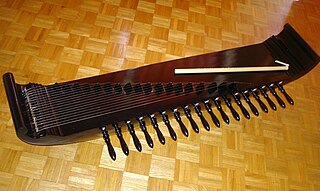
The kacapi is a traditional zither of Sundanese people in Indonesia. This musical instrument is similar to Chinese guzheng, Japanese koto, the Mongolian yatga, the Korean gayageum, the Vietnamese đàn tranh and the Kazakh jetigen. The kacapi played as the main accompanying instrument in the Tembang Sunda or Mamaos Cianjuran, kacapi suling genre, pantun stories recitation or an additional instrument in Gamelan Degung performance.

Gamelan degung is a form of Sundanese musical ensemble that uses a subset of modified gamelan instruments with a particular mode of degung scale. The instruments are manufactured under local conditions in towns in West Java such as Bogor and Bandung. Degung music is often played at public gatherings in West Java, such as at local elections, as well as many other events. There is international interest in degung as well among communities in other countries interested in Indonesian and gamelan music.
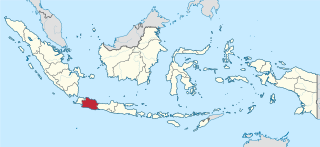
West Java is an Indonesian province on the western part of the island of Java, with its provincial capital in Bandung. West Java is bordered by the province of Banten and the country's capital region of Jakarta to the west, the Java Sea to the north, the province of Central Java to the east and the Indian Ocean to the south. With Banten, this province is the native homeland of the Sundanese people, the second-largest ethnic group in Indonesia.
Pelog is one of the essential tuning systems used in gamelan instruments that has a heptatonic scale. The other, older, scale commonly used is called slendro. Pelog has seven notes, but many gamelan ensembles only have keys for five of the pitches. Even in ensembles that have all seven notes, many pieces only use a subset of five notes, sometimes the additional 4th tone is also used in a piece like western accidentals.
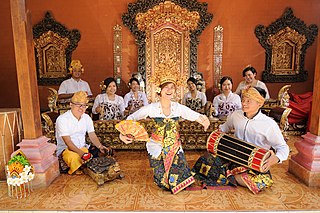
The Music of Bali, Bali is an Indonesian island that shares in the gamelan and other Indonesian musical styles. Bali, however, has its own techniques and styles, including kecak, a form of singing that imitates the sound of monkeys. In addition, the island is home to several unique kinds of gamelan, including the gamelan jegog, gamelan gong gede, gamelan gambang, gamelan selunding and gamelan semar pegulingan, the cremation music angklung and the processional music bebonangan. Modern popular styles include gamelan gong kebyar, dance music which developed during the Dutch occupation and 1950s era joged bumbung, another popular dance style. In Balinese music you can also hear metallophones, gongs and xylophones.

The angklung is a musical instrument from the Sundanese in Indonesia that is made of a varying number of bamboo tubes attached to a bamboo frame. The tubes are carved to produce a resonant pitch when struck and are tuned to octaves, similar to Western handbells. The base of the frame is held in one hand, while the other hand shakes the instrument, causing a repeating note to sound. Each performer in an angklung ensemble is typically responsible for just one pitch, sounding their individual angklung at the appropriate times to produce complete melodies.

The suling is a musical instrument of the Sundanese people in Indonesia. It is used in the Degung ensemble. Bamboo ring flute can also be found in Southeast Asian, especially in Brunei, Indonesia, Malaysia, the Philippines and Singapore.
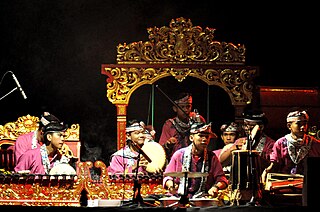
Gamelan beleganjur is one of the most popular styles of gamelan music in Bali. Its closest Western analogue is probably the Western military band.

Gugum Gumbira Tirasondjaja, often known just as Gugum Gumbira, was a Sundanese composer, orchestra leader, choreographer, and entrepreneur from Bandung, West Java, Indonesia.

The bonang is an Indonesian musical instrument used in the Javanese gamelan. It is a collection of small gongs placed horizontally onto strings in a wooden frame (rancak), either one or two rows wide. All of the kettles have a central boss, but around it the lower-pitched ones have a flattened head, while the higher ones have an arched one. Each is tuned to a specific pitch in the appropriate scale; thus there are different bonang for pelog and slendro. They are typically hit with padded sticks (tabuh). This is similar to the other cradled gongs in the gamelan, the kethuk, kempyang, and kenong. Bonang may be made of forged bronze, welded and cold-hammered iron, or a combination of metals. In addition to the gong-shaped form of kettles, economical bonang made of hammered iron or brass plates with raised bosses are often found in village gamelan, in Suriname-style gamelan, and in some American gamelan. In central Javanese gamelan there are three types of bonang used:
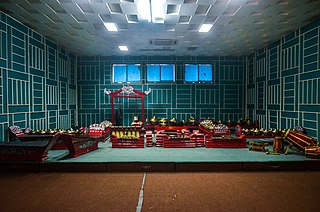
The gamelan salendro is a form of gamelan music found in West Java, Indonesia. It is played as an accompaniment to wayang golek performances and dances. It uses a similar ensemble as a small central Javanese gamelan, but has developed differently, and shows the more exuberant character.
Gamelan siteran is a casual style of gamelan in Java, Indonesia, featuring portable, inexpensive instruments instead of the heavy bronze metallophones of a typical gamelan. A typical group consists of varieties of siter, kendang (drum), and a large end-blown bamboo tube or a gong kemodhong, functioning as a gong ageng. A full group has a celempung, siter, siter panerus, siter slenthem, kendhang ciblon, and gong kemodhong. It is typically accompanied by singing as well. The instruments are often homemade, something which is impossible with the more characteristic gamelan instruments. Performances are usually of pieces from the standard Javanese gamelan repertoire.

Tembang sunda, also called seni mamaos cianjuran, is a style of classical vocal music that originated in the Priangan highland of western Java. Unlike Sundanese gamelan music, tembang sunda was developed in the court of the regent Kabupaten Cianjur during the Dutch colonial period. The traditional vocal portion is sung free verse poetry, the instrumental accompaniment being performed on kacapi (zither), suling and sometimes, rebab (violin). A more modern, and metrical, form of lyrics exists that is called panambih.
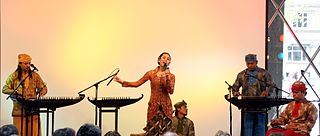
SambaSunda is an Indonesian ethnic music fusion group based in Bandung, the capital and cultural centre of Sundanese culture in Indonesia. SambaSunda is a 14-piece ensemble bringing together a pan-Indonesian array of instruments and influences to create a new style of gamelan orchestra. Their style is mainly influenced by Sundanese culture, such as gamelan and degung Sunda, Tembang Sunda, and Kacapi suling.

Sundanese dances is a dance tradition that is a part of ritual, artistic expression as well as entertainment and social conduct among the Sundanese people of West Java and Banten, Indonesia. Sundanese dance is usually cheerful, dynamic and expressive, with flowing movements in-sync with the beat of kendang accompanied with Gamelan degung music ensemble.

Sandiwara is a genre of traditional theatrical drama of Indonesia. In general, it refers to any kind of drama or theatrical performance, and literally, sandiwara means "to pretend" or "to act". However, the term is often used to describe a genre of traditional drama of West Java. Sandiwara Sunda is a type of sandiwara performed in Sundanese and presenting Sundanese themes, folklores and stories. It is quite similar to Javanese ketoprak or wayang orang.

Sundanese Music is an umbrella term that encompasses diverse musical traditions of the West Java and Banten in western part of Java, Indonesia. The term of "West Java" is preferred by scholars in this field. The word "Sundanese" originally referred to western part of Java Island and has a strong association with the highly centralized Sunda Kingdom based on Java Island and its high culture practiced by the nobleman class in its capital Parahyangan. By contrast, scholars who cover a much broader region lay emphasis on folk culture.